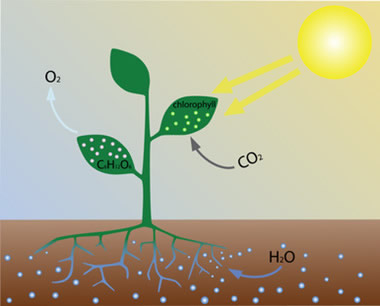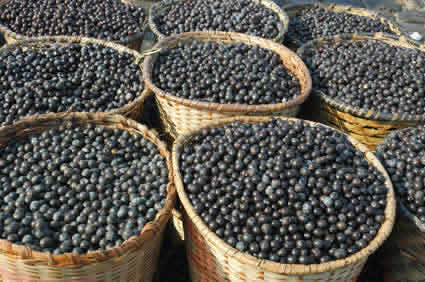Chlorophyll is actually responsible for the green pigmentation in plants. Plants use chlorophyll to trap light needed for photosynthesis. The chlorophyll molecule is very similar in structure to the haemoglobin molecule. The difference between them is that the heme molecule contains the element iron at its centre, whereas the chlorophyll molecule, also an oxygen-carrier contains magnesium.
Natural Chlorophyll Sources
Chlorella, spirulina, wheat grass, alfalfa, sea vegetables, nettle, green leafy sprouts, green cabbage, brussels sprouts, broccoli, spinach, asparagus, kale.
Chlorophyll Therapeutic Effects and Benefits
In 1913, Dr. Richard Willstatter, a German researcher, discovered the functions of chlorophyll. The healing aspects of chlorophyll were reported in 1940 by Dr. Benjamin Gruskin. Researchers in the early 1980s discovered that chlorophylls and related chemicals could inhibit the ability of certain DNA-damaging chemicals to cause mutations in bacteria. Chlorophyll consumption increases the number of red blood cells and, therefore, increase oxygen utilization by the body. Young barley grass juice contains 66 times more chlorophyll than spinach and is therefore one of the best natural sources of chlorophyll.
 Chlorophyll detoxifies the liver, kidney, bowel and bloodstream and helps eliminate toxins that can damage health. Also, helps neutralize normal body odors and acts as a natural deodorant. In the 1940s chlorophyll began to be used as an internal deodorant for individuals with colostomies in order to control fecal odor. Dr. Wescott reported that when chlorophyll is taken internally in adequate quantities, it reduces or eliminates offensive body and breath odors.
Chlorophyll detoxifies the liver, kidney, bowel and bloodstream and helps eliminate toxins that can damage health. Also, helps neutralize normal body odors and acts as a natural deodorant. In the 1940s chlorophyll began to be used as an internal deodorant for individuals with colostomies in order to control fecal odor. Dr. Wescott reported that when chlorophyll is taken internally in adequate quantities, it reduces or eliminates offensive body and breath odors.
Research and clinical experiences have shown that chlorophyll can be a highly effective substance to help heal external wounds and lesions. Chlorophyll powerful suit tends to be its capability to accelerate the formation of granulation tissue that forms the base for new tissue growth in wound healing. During the late 1940s, several studies in people with slow-healing wounds, such as vascular ulcers and pressure ulcers, reported that the application of topical chlorophyllin promoted amelioration more effectively than other commonly used therapies.
Chlorophyll is a strong antioxidant. A 1998 study by Brazilian scientist, M.S. Miranda, demonstrated that spirulina, rich in chlorophyll, phenolic acids, alpha-carotene and beta-carotene, all showed strong free-radical antioxidant protection in test-tube and experimental models. Chlorophyll protects cells against the negative effects of radiation, such as from X-rays. In a study reported in Molecular Immunology in 2007, scientists found chlorophyll stimulated the immune system in mice and protective against radiation-induced immune suppression.
Chlorophyll is a very good source of vitamin K. As an valuable natural source of vitamin K, chlorophyll can be used where there is a difficulty in the production of clotting factors or proteins needed for normal calcification of bone. Vitamin K, as a prothrombin factor and capillary integrity support, is important in cardiovascular conditions and circulatory problems such as phlebitis and varicose veins.
Chlorophyll is considered to be a blood builder and can be used in cases of anemia. These nutrients helps red blood cells collect oxygen to enhance cell regeneration. Chlorophyll enhances the capability of nutrients that build iron in the body and so it develops the production of red blood cells. Also, because it contains magnesium, enhances the transportation of oxygen to the tissues, develops circulation and oxygen supply. In 1934, Dr. Rothemund discovered that porphyrins from chlorophyll stimulated the synthesis of red blood cells in a various of animals when fed in low dose. It was in 1936 when Dr. Arthur Patek reported the important findings from the study done with 15 people who were diagnosed of anemia. Fifteen participant with iron-deficiency anemia were fed different amounts of chlorophyll with iron. The level of blood hemoglobin and the number of red blood cells increased faster than with taking iron alone. Based on the knowledge that injections of chlorophyll increased the red blood cell counts of those with normal haemoglobins it was then showed that the same therapy could raise the haemoglobin of those who are anaemic. Animals were bled and their haemoglobin levels decreased to 50% of the normal. Within two weeks those being fed on wheatgrass had entirely normal haemoglobin levels. J H Hughs and A L Latner, Journal of Physiology 1936. The Healing Powers of Chlorophyll
Chlorophyll is a important source to a healthy alkaline diet. Living things are extremely sensitive to pH and function best when solutions are nearly neutral. Most interior living matter (excluding the cell nucleus) has a pH of approximately 6.8. When the body’s pH is too acidic, cells cannot function at their optimal level. This is why a person is more likely to become ill, develop infections, or even develop cancer when their diet is acidic as compared to alkaline. Test tube studies support the fact that tumors grow faster in more acidic environments.
Researches in humans have found that damage to DNA by aflatoxin can be reduced 55% through supplement with chlorophyllin at 100 mg, 3 times a day, for 4 months. Aflatoxin-B1 is produced by a fungus which lives on moldy grains, corn and beans. In a study, participants took either 100 milligrams of chlorophyllin or a placebo before meals 3 times daily. After 16 weeks of therapy, urinary levels of AFB 1 -N 7 -guanine were 55 percent lower in those taking chlorophyllin than in those taking the placebo, suggesting that chlorophyllin supplement before meals can significantly reduce AFB 1 -induced DNA damage. (A biomarker of AFB 1 -induced DNA damage (AFB 1 -N 7 -guanine) can be measured in the urine, and high urinary levels of AFB 1 -N 7 -guanine have been associated with significantly increased risk of developing hepatocellular carcinoma). Chlorophyll and Chlorophyllin
Dosage
For bad breath, 100 mg has been taken 2 or 3 times daily. For colostomy odor, 75 mg 3 times daily for up to 100-200 mg daily in divided doses has been used. Doses of 100 milligrams 3 times per day for up to 4 months have been used in a study on preservation against aflatoxins. For pneumonia, infusion of 0.25% chlorophyllipt solution in physiological sodium chloride solution administered by intravenous drip has been investigated.
 Acai berry contains compounds called anthocyanins and flavonoids. Flavonoids and anthocyanins are strong antioxidants that help defend the body against life’s stressors. Antioxidants protect against free radicals, highly reactive atoms and molecules that can damage DNA and other important molecules in the cell. Free radicals are the result of some oxygen molecules that are converted into oxidizing substances during the process that creates energy in cells, cellular respiration. Oxygen is a very active element, and in the stage of exchanging the molecules in the bloodstream, oxygen combines with many different compounds. Some of these compounds can cause damage to body tissue. Oxidative stress has been implicated in the development of a number of conditions including arthritic disorders, cancer, and cardiovascular problems.
Acai berry contains compounds called anthocyanins and flavonoids. Flavonoids and anthocyanins are strong antioxidants that help defend the body against life’s stressors. Antioxidants protect against free radicals, highly reactive atoms and molecules that can damage DNA and other important molecules in the cell. Free radicals are the result of some oxygen molecules that are converted into oxidizing substances during the process that creates energy in cells, cellular respiration. Oxygen is a very active element, and in the stage of exchanging the molecules in the bloodstream, oxygen combines with many different compounds. Some of these compounds can cause damage to body tissue. Oxidative stress has been implicated in the development of a number of conditions including arthritic disorders, cancer, and cardiovascular problems.  Bee pollen contains rutin, which strengthens capillaries and blood cell walls. Rutin is a glucoside that provides increased resistance to the walls of the capillaries, and its basic function is to reinforce the general resistance throughout the entire capillary system. Also, strengthens the heart, and helps control high blood pressure.
Bee pollen contains rutin, which strengthens capillaries and blood cell walls. Rutin is a glucoside that provides increased resistance to the walls of the capillaries, and its basic function is to reinforce the general resistance throughout the entire capillary system. Also, strengthens the heart, and helps control high blood pressure. zeaxanthin).
zeaxanthin).